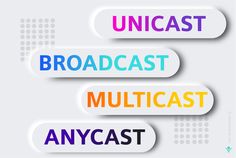Anycast vs. Unicast vs. Multicast vs. Broadcast: A Comprehensive Comparison

The transmission of data over the internet is an essential aspect of modern-day communication, particularly in the world of IPTV. Anycast, unicast, multicast, and broadcast are different types of data transmission methods used in IPTV networks. Each method has its own advantages and disadvantages. In this article, we will take a comprehensive look at the comparison of these transmission methods, their characteristics, and their appropriate uses in IPTV. Therefore, it is important to understand these transmission methods to choose the right method for the right scenario. By understanding these transmission methods, IPTV providers can ensure that they are using the most appropriate method for their network, which can lead to a better streaming experience for users.
To gain sufficient knowledge about Anycast vs. Unicast vs. Multicast vs. Broadcast, it is imperative that you read this article in its entirety. Using these different data transmission methods requires an understanding of their unique characteristics and appropriate use cases. Therefore, taking the time to read this article will provide you with the necessary knowledge to make informed decisions in managing network traffic and ensuring efficient data delivery.
Introduction
The development of the internet and the emergence of IPTV technology have revolutionized the way data is transmitted over the network. As a result, data transmission methods like anycast, unicast, multicast, and broadcast have become essential for managing network traffic and ensuring efficient data delivery. Each of these transmission methods has a specific use case that depends on the nature of the network and the type of data being transmitted. Therefore, this article aims to provide a comprehensive comparison of anycast, unicast, multicast, and broadcast transmission methods.
Anycast
In anycast, a group of potential destinations receives data, but only the nearest or best destination will receive the data sent by a single sender. Anycast helps improve network performance, reduce latency, and prevent network congestion. It is suitable for applications that require low latency and fast response time.

Advantages of Anycast:
- Low latency
- High network availability
- Reduced network congestion
- Improved network performance
Disadvantages of Anycast:
- Limited scalability
- Limited support for large-scale networks
- Difficult to manage and configure
Use cases of Anycast:
- Content delivery networks (CDNs)
- Distributed Denial of Service (DDoS) protection
- Routing protocols
Unicast
Unicast is a data transmission method that involves sending data from one sender to one receiver. Specifically, a single sender sends data to a single receiver, making it ideal for applications that require a dedicated communication channel between the two endpoints. Additionally, unicast is ideal for applications that demand high security and reliability. Moreover, unicast sends data from one sender to one receiver, with the intended recipient receiving the data. This ensures that data transmission is directed to the desired endpoint, making it a reliable option.
Advantages of Unicast:
- High security
- High reliability
- Low network congestion
- Easy to manage and configure
Disadvantages of Unicast:
- Limited scalability
- High network overhead
- High latency
Use cases of Unicast:
- Video conferencing
- IPTV streaming
- File transfer
Multicast
Multicast is a network addressing and routing methodology that allows data to be sent from one sender to a group of receivers. With multicast, the sender transmits data to multiple receivers, and each receiver receives the data simultaneously. Multicast is an effective way to conserve network bandwidth and reduce network congestion. It is ideal for applications that require the same data to be delivered to multiple recipients at the same time, such as live video streaming, audio broadcasting, and online gaming.
Advantages of Multicast:
- Efficient use of network bandwidth
- Reduced network congestion
- Low network overhead
- Easy to manage and configure
Disadvantages of Multicast:
- Limited support for large-scale networks
- High latency
- Security concerns
Use cases of Multicast:
- IPTV streaming
- Video conferencing
- Online gaming
Broadcast
Broadcast uses a one-to-all data transmission method that sends data to all devices in the network, regardless of their requirement for it. People commonly use this method to send data to all devices on the network, for instance in network discovery or time synchronization protocols. However, limited bandwidth makes the broadcast method unsuitable as it can cause unnecessary network congestion.

Advantages of Broadcast:
- Implementing broadcast is simple, and it does not necessitate any further network configuration.
- It is a reliable method for sending data to all devices in the network.
Disadvantages of Broadcast:
- It can cause unnecessary network congestion, especially in large networks.
- Broadcast is not suitable for scenarios where bandwidth is limited.
Similarities and Differences between Anycast, Unicast, Multicast, and Broadcast:
These network technologies have similarities and differences if you want to know more about Anycast vs. Unicast vs. Multicast vs. Broadcast.

- In computer networks, devices use all of these transmission methods to send data to each other.
- Anycast, unicast, multicast, and broadcast differ in the way data is sent and how it is received by devices in the network.
- Anycast and unicast are point-to-point communication methods, while multicast and broadcast are one-to-many communication methods.
- In computer networks, people use Anycast to send data to the nearest device, while they use Unicast to send data to a specific device.
- Applications use multicast to send data to a group of interested devices, whereas they use broadcast to send data to all devices in the network.
- Scenarios with limited bandwidth are suitable for anycast, unicast, and multicast, while the broadcast is not suitable.
Conclusion:
In conclusion, it is crucial to understand the differences between anycast, unicast, multicast, and broadcast in computer networking to choose the appropriate transmission method for a specific scenario. In the context of IPTV, these transmission methods are used to send data between the streaming server and the user’s device, and the selection depends on the network architecture and the number of users. By choosing the most suitable method, IPTV providers can enhance the streaming experience for users.



0 Comments